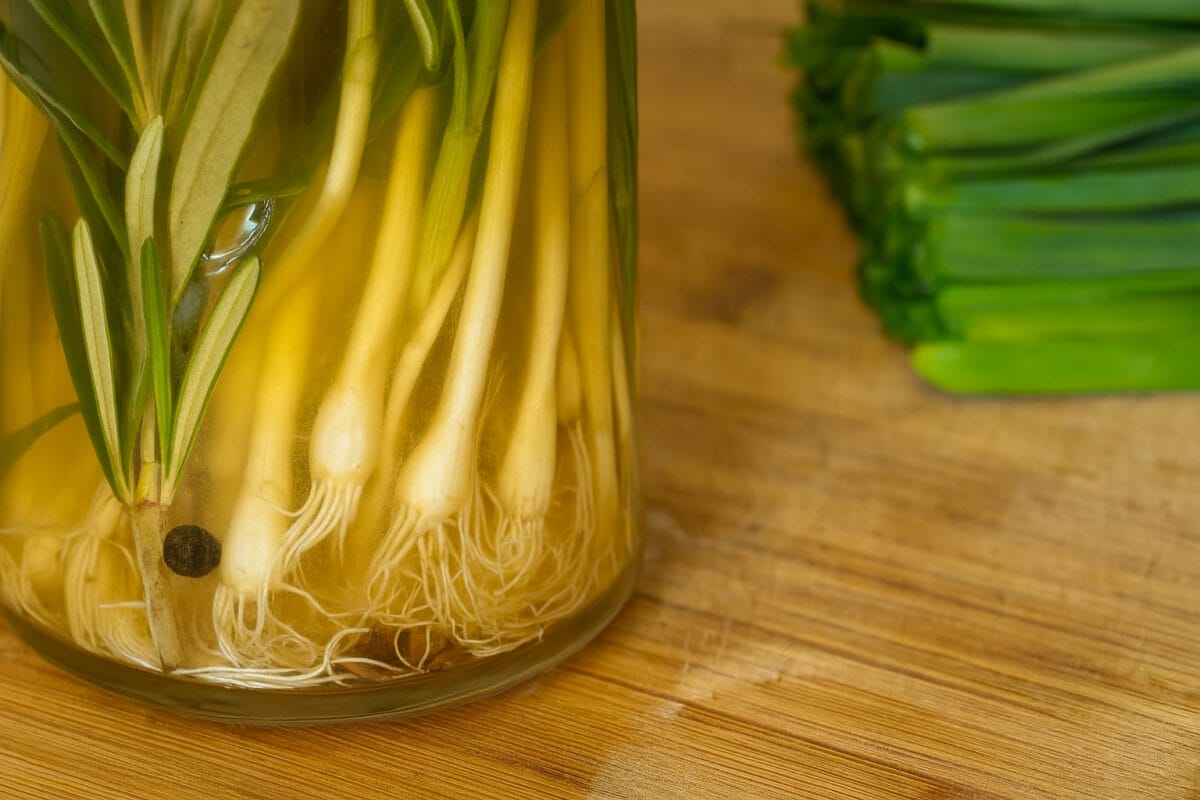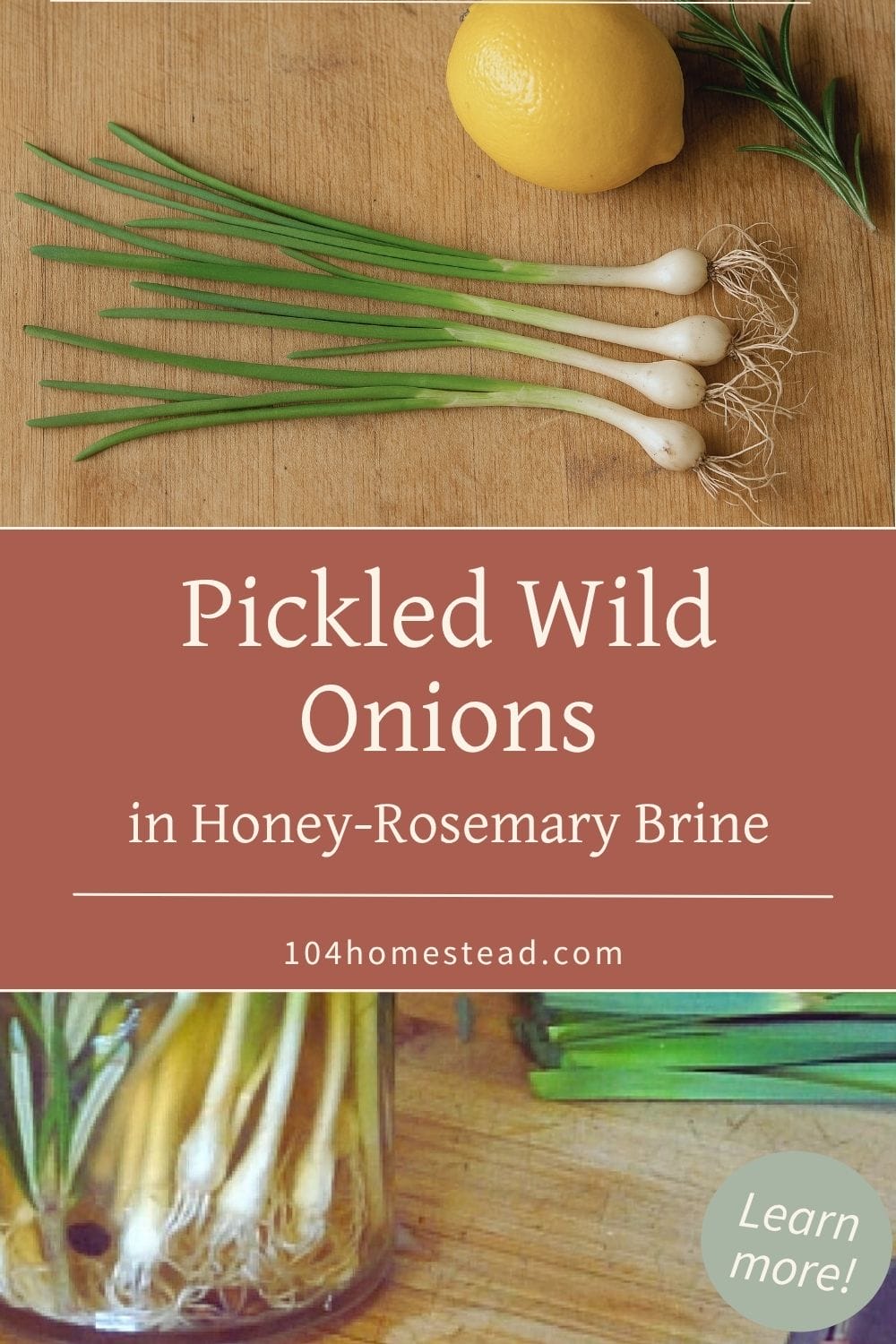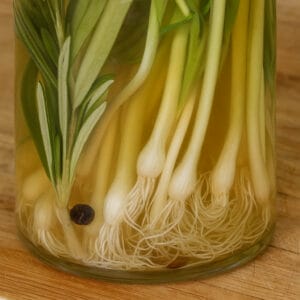Pickled Wild Onions with a Honey-Rosemary Brine
These pickled wild onions in honey-rosemary brine are a sweet, savory, and tangy way to preserve spring’s first forage.

The first signs of wild onions popping up in the yard always feel like a seasonal reset—something fresh, vibrant, and just a little wild. Their tender bulbs and garlicky greens are one of the earliest edible gifts nature offers each spring, and every year I look forward to preserving some in this flavorful honey-rosemary brine.
New to foraging? Start by learning about the most common edible plants that might be growing just steps from your front door.
Pickled wild onions are bright, tangy, and slightly sweet with just enough bite to keep things interesting. They’re perfect on a charcuterie board, tucked into sandwiches, or chopped into a vinaigrette. This is one of those small-batch recipes that feels fancy but is incredibly easy to make. And yes, the greens are edible too—so nothing goes to waste.
Why Make Pickled Wild Onions
There are a few reasons this recipe has become a yearly ritual at my house.
1. They’re seasonal and abundant.
Wild onions often grow in tucked-away corners of your yard, garden, or pasture—and once you spot one, you’ll likely find a dozen more.
2. The flavor is mild but complex.
They’re less intense than garlic but still bring that same punch to savory dishes. Pickling them with honey and rosemary gives the bulbs a delicate balance of sweet, sour, and herbal.
3. You can use every part of the plant.
The pickled bulbs go in the jar, and the greens are perfect chopped over eggs, tossed into soup, or added to pasta salads for a fresh, oniony kick.
Tip: You can also use this same brine on green onions, garlic cloves, shallots, and more—whatever you have on hand. Planning to pickle garlic too? Make sure you know the best way to preserve it long-term for flavor and freshness.
How to Identify Wild Onions
Wild onions (Allium canadense or Allium vineale) look a lot like chives or young garlic—but you’ll know you have the real thing by the strong onion smell. If the plant doesn’t smell like onion or garlic, don’t eat it. Some look-alikes, like death camas, are toxic.
Here’s what to look for:
- Thin, hollow green shoots about the width of a pencil
- Small white bulbs at the base, sometimes tinged with pink
- A distinct onion or garlic smell when cut or crushed
They typically grow in sunny, open spaces with well-drained soil. You’ll often spot them growing in tufts or clumps in spring and fall.
Heads up: Always harvest responsibly—never take more than you need, and be sure you’re on land where foraging is permitted.
Ingredients You’ll Need
This simple brine creates a sweet, tangy base that complements the wild onions beautifully. It works well for other alliums too!
- Wild onions (cleaned and trimmed to fit your jar)
- Apple cider vinegar
- Honey
- Water
- Lemon juice
- Salt
- Black peppercorns
- Fresh rosemary
Step-by-Step Instructions
Once your wild onions are cleaned and trimmed, you’re only about 10 minutes away from getting them into the jar.
- Pack the wild onions into a clean glass jar, leaving a little space at the top.
- Combine the brine ingredients in a small saucepan: vinegar, honey, water, lemon juice, salt, and peppercorns.
- Bring the mixture to a boil, stirring to dissolve the honey and salt completely.
- Boil for 2 minutes, then carefully pour the hot brine over the onions.
- Tuck in the rosemary sprig, making sure it’s submerged.
- Let the jar cool to room temperature, then seal and store in the fridge.
- Wait at least one week before tasting—longer for a deeper flavor.
Tip: These pickles will last several months in the refrigerator.

Ways to Use Pickled Wild Onions
Pickled wild onions are incredibly versatile. Once you try them, you’ll be looking for excuses to pop one in everything.
- Chop and stir into egg or potato salad
- Add to a charcuterie board or antipasto platter
- Layer onto sandwiches or burgers
- Stir into sour cream or yogurt for a savory dip
- Serve alongside grilled meat or fish for a bright finish
Don’t forget about the greens either—try them in place of green onions in any recipe.
Frequently Asked Questions about Pickled Wild Onions
Still have questions? Here are a few common ones I get when talking about pickled wild onions.
Love wild food and seasonal recipes? Save this one to your Foraging or Preserving board so you can find it later!

Pickling wild onions is one of those small, satisfying acts of seasonal living that reminds me why I love homesteading. It’s simple, it’s thrifty, and it turns something humble into something worth savoring.
Whether you’re adding them to sandwiches, mixing them into a salad, or just sneaking one straight from the jar (no judgment), these pickled wild onions are a flavorful way to make the most of what’s growing around you.
If you give this recipe a try—or find another use for that honey-rosemary brine—I’d love to hear about it in the comments. And if foraging is new to you, let this be your sign to get out there and see what nature’s pantry has to offer.
Happy pickling!

Pickled Wild Onions in Honey-Rosemary Brine
This post may contain paid links. If you make a purchase using the links in this recipe, I may earn a commission.
Equipment
- 1 Pint Mason Jar
Ingredients
- 1½ cups Wild Onions cleaned and trimmed to fit jar
- ½ cup Apple Cider Vinegar
- ½ cup Honey
- ¼ cup Water
- 2 tablespoons Lemon Juice
- 6 Peppercorns whole
- 1 teaspoon Salt
- 1 Fresh Rosemary Sprig
Instructions
- Clean and trim the wild onions, removing roots and any papery outer skins. Cut greens to fit the height of your jar.1½ cups Wild Onions
- Pack the onions into a clean pint-size glass jar, leaving room at the top for the brine.
- In a small saucepan, combine vinegar, honey, water, lemon juice, peppercorns, and salt.½ cup Apple Cider Vinegar, ½ cup Honey, ¼ cup Water, 2 tablespoons Lemon Juice, 6 Peppercorns, 1 teaspoon Salt
- Bring the mixture to a boil, then simmer for 2 minutes to fully dissolve the honey and salt.
- Carefully pour the hot brine over the onions in the jar, making sure they’re fully submerged.
- Tuck the rosemary sprig into the jar and gently press to release its oils.1 Fresh Rosemary Sprig
- Let the jar cool to room temperature, then seal with a lid and store in the refrigerator.
- Allow the onions to pickle for at least one week before enjoying for best flavor.
Notes
- This brine works well with garlic cloves, green onions, or sliced shallots if you don’t have access to wild onions.
- For best results, use a glass jar with a non-reactive lid.
- The onions will soften slightly but still retain a pleasant crunch.
Nutrition
Love a good crunch? If you enjoy homemade pickles, don’t miss my simple trick for getting them perfectly crisp every time.

Does the pickling juice have to be to the top of the jar? The jar I’m using for this recipe might be too big?
Do you just eat them as is or use them in other dishes? As is, is fine with me but what do you normally do?
Hi! I just stumbled across your site and was wondering, in your opinion how long would you store this and how? Also, have you ever processed this recipe in a boiling water bath for longer term storage?
Because of the pickling process it lasts quite a long time. I haven’t tried canning it, so I can’t say how well that would work.
I am saving this, printing and using to Pickle some Ramps this spring.
I love Ramps, and this recipe looks like it would be a good one for them too.
Thanks for sharing it and I will let you know how it turns our, when they finally come up thru the snow. LOL
Very similar to ramps– that will be delicious! Let us all know!
Yum! So are these actually wild (i.e. foraged) or are they called wild onions (please excuse my ignorance). Either way, they sound delicious 🙂
Hi Anne Marie! Sorry I missed your question! They are a wild (foraged) vegetable, more like garlic than onion but called wild onions. Very tasty. They grow in little clumps.